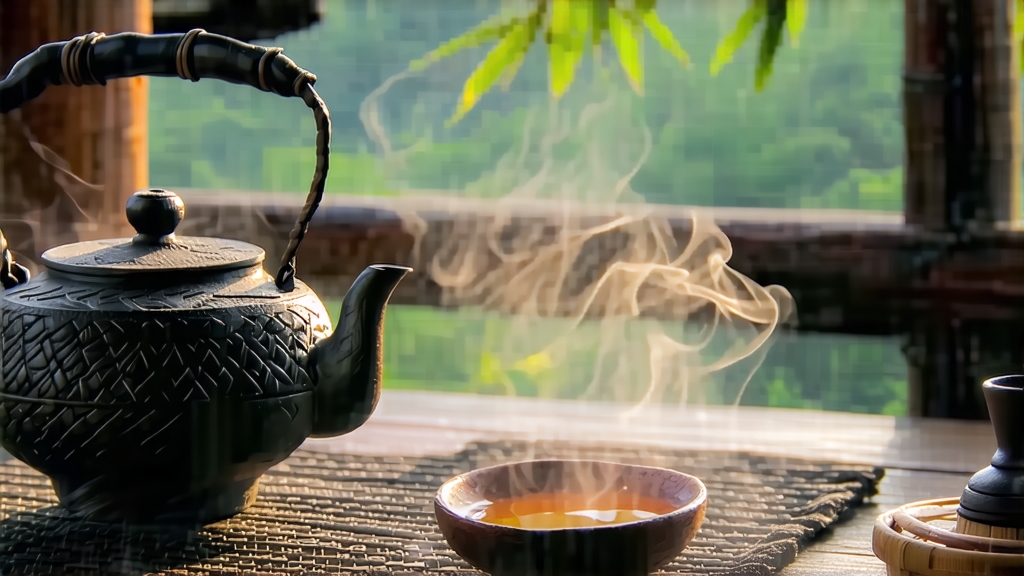
Tucked into the southern folds of China’s Guangxi Zhuang Autonomous Region, where the mist clings to karst peaks and the Liu River bends like a calligrapher’s brushstroke, Liu Bao tea has quietly matured for almost fifteen hundred years. International drinkers may speak reverently of Pu-erh, yet in the trading posts of old Wuzhou, Liu Bao was the currency that bought rice, salt, and safe passage for boatmen drifting toward Southeast Asia. Its leaves once traveled the “Tea Road to the Sea,” pressed into coarse baskets, absorbing the humidity of riverboats and the smoke of opium lamps, emerging at port with a scent that Cantonese merchants described as “old library and rain-soaked betel.” Today the same tea is courted by collectors in Kuala Lumpur who age it alongside sandalwood cabinets, and by Tokyo sommeliers who pair its cocoa-bitter finish with raw sea urchin. To understand Liu Bao is to listen to a living archive of southern China’s migrations, wars, and appetites.
Although officially classified as a dark tea (heicha), Liu Bao refuses to be a single, static style. The micro-region alone—barely 200 square kilometers around the town of Liubao in Cangwu County—produces three recognized sub-types. “Mountain Liu Bao” grows above 400 m on red lateritic soil, yielding smaller leaves high in catechins that turn into leather and camphor after a decade. “River Liu Bao” comes from alluvial terraces where night dew is heavy; its broader leaves ferment faster, giving a sweet, almost jujube-like liquor within three years. Finally, “Old Forest Liu Bao” is picked from feral shrubs seeded by Song-dynasty monks; farmers enter the forest only twice a year, armed with machetes and offerings of rice wine to the tree spirits, then carry the wild leaves out in shoulder baskets lined with banana leaves. Each sub-type is further divided into “Sheng” (raw, slow-aged) and “Shu” (wet-piled, accelerated), creating a matrix of flavors that can baffle even seasoned pu-erh drinkers.
The craft begins in late April when the first monsoon clouds roll in. Pickers take one bud and three or four leaves—larger, tougher blades than those coveted for green tea—because the extra fiber will withstand the humid fermentations ahead. The leaves are briefly wilted on bamboo screens set over the kitchens, absorbing the smoke from camphor-wood fires that boil breakfast rice. A quick kill-green at 200 °C deactivates enzymes yet preserves surface microbes; masters judge the timing by the sound of leaves crackling like thin ice. Rolling is still done by foot inside a waist-high wok: the worker rocks heel-to-toe for exactly 1,200 steps, a rhythm learned from boat-rowing chants. After sun-drying, the maocha rests for one lunar month so that indigenous yeasts—mostly Cyberlindnera and Candida species—can colonize the leaf.
What follows is the decisive act that separates Liu Bao from other dark teas: the “dui wo” wet-piling. Instead of the 45-day Pu-erh pile, Liu Bao is heaped for only 18–22 days in bamboo rooms with operable plank walls. Every dawn the tea master, always barefoot to feel temperature through the soles, sprays river water drawn before sunrise while singing the old five-note scale; the vibrations, he claims, guide airflow. Midday heat is vented by lifting floorboards, letting mountain breeze cool the pile from below, a technique borrowed from rice-yeast growers. On day seven the heap is restacked with layers of sweet-flag leaves (Acorus calamus), a local herb that deters harmful molds and imparts a faint spicy note reminiscent of myrrh. When the leaf core hits 58 °C the pile is broken down, pressed into 40 kg bamboo baskets lined with untreated cotton, and moved to riverside caves where relative humidity hovers at 85 %. There the tea will sleep for a minimum of three years, often twenty, while the river’s diurnal sighs rock the baskets gently, compacting the leaves into dark, glossy bricks.
Aging Liu Bao is a dialogue between tea and container. Traditional “Long jars”—unglazed clay crocks fired from local kaolin—breathe